#Michael Laub
Text
Sinead O'Brien - European Tour 2022
Sinead O’Brien – European Tour 2022
“You have seen nothing yet”, asserts Sinead O’Brien in single Girlkind – and you are inclined to believe her. Building on her arresting releases since 2018, the multifaceted Irish poet, songwriter and performer is ascending into new territory with her debut LP, Time Bend and Break the Bower, released via Chess Club Records.
Demanding a visceral response from her audiences, O’Brien issues a…

View On WordPress
#album#Alessandro Michele#chess records#dance#europe#film#Gucci#Helmut Newton#Henri Cartier-Bresson#history of art#Ireland#iron man records#John Galliano#Michael Clark#Michael Laub#music#Photography#poet#poetess#poetry#pop#rock#Samuel Beckett#Sinead O&039;Brien#tour#tour dates#uk#united kingdom#Virginia Woolf#Vivienne Westwood
2 notes
·
View notes
Link
Check out this listing I just added to my Poshmark closet: Thomas Organ Solos Broadway Shows Mame Musical Sheet Music 1967 Jerry Herman Vtg.
0 notes
Text
Fresh Picks: Wyersound / Nikita Lev / Fulton Calvery / Asher Laub / Michael Pinning / matty C / SAM LONDON / Molly Comfort / The Temblors / Michael Ellery
Fresh Picks by Amelia, the following tracks are a selection by me that definitely deserve more attention than Miley Cyrus!
Billie by Wyersound
https://soundcloud.com/user-537054379/billie
Nowhere Bar by Nikita Lev
Gypsy Queen by Fulton Calvery
Shemesh by Asher Laub
Anything Better by Michael Pinning
Key Largo (feat. DrewOGsan) by matty C
Love You Again by SAM LONDON
Where You’d Rather Be…

View On WordPress
0 notes
Text
Recyclingwunder Biomüll

Tag der Biotonne am 26.05.2023
Bio- und Grünabfälle werden im Kreis Wesel schon lange getrennt erfasst. Die Vorgänge, die jeder vom Komposthaufen im Garten kennt, sind im Bio-Kompostwerk am Asdonkshof perfektioniert und optimiert. Dabei entsteht – wie im Garten – Bio-Kompost. Das ist Kreislaufwirtschaft par excellence. Zum heutigen Tag der Biotonne stellen wir das Recyclingwunder Biomüll vor – und auch, was beim Befüllen der Biotonne zu beachten ist.
Bio-Kompost aus Bioabfall schließt natürliche Kreisläufe und schützt die Umwelt
Am Asdonkshof wird aus Bioabfall – also aus Lebensmittelresten, Obst- und Gemüseschalen, Heckenschnitt und Laub – wertvoller Bio-Kompost. Dieser gibt dem Boden die entnommenen Nährstoffe zurück, die ihm durch den Pflanzenanbau entnommen wurden. Damit stabilisiert und verbessert er den Humusgehalt und die wertvollen Funktionen der Böden. Bio-Kompost hilft, die Verwendung von Torf zu ersetzen und wirkt durch seine Nährstoffe positiv auf Pflanzen und Umwelt. Die korrekte Getrenntsammlung von Bioabfällen und der Einsatz von Bio-Kompost sind zudem ein wesentlicher Faktor, wenn es um die Reduktion des CO2-Ausstoßes geht.
Klimaschutz fängt durch richtiges Mülltrennen zu Hause an
Der Bio-Kompost kann sein gutes Werk nur vollbringen, wenn der Bioabfall vorher richtig getrennt wurde. Störstoffe wie Plastik, kompostierbare Plastiktüten oder andere als kompostierbar deklarierte Verpackungen oder Produkte, Glas oder Metall haben in der Biotonne nichts zu suchen. All das muss im Bio-Kompostwerk am Asdonkshof aufwändig aussortiert werden. Trotzdem verunreinigen kleinteilige Plastikrückstände den Kompost, setzten die Qualität herab und stören den Verwertungsprozess. Denn die im Kompost zerfallenden Reste, also Mikroplastik, lassen sich biologisch nicht abbauen und gelangen im schlimmsten Fall über den Bio-Kompost auf Beete oder Äcker, ins Grundwasser oder in die Nahrungskette.
Deshalb heißt es bei der bundesweiten Kampagne #wirfuerbio und im Kreis Wesel: Kein Plastik in die Biotonne!
Die Luftaufnahme (Foto: Michael Ricks) zeigt das sich noch in Betrieb befindende Bio-Kompostwerk (mit
Photovoltaik-Elementen auf dem Dach) sowie die Baustelle der neuen Vergärungsanlage (unten links). Im
nächsten Jahr werden Bioabfälle am Standort Asdonkshof dann nicht nur zu wertvollem Biokompost,
sondern zusätzlich auch in Energie (Strom) umgewandelt
Read the full article
0 notes
Text
Geführte Fackelwanderung für die ganze Familie (Kopie)
Winterlicher Wald, knisterndes Laub - oder gar Schnee? - unter den Schuhen… der Wind fegt durch kahle Äste… eine Atmosphäre wie geschaffen für viel Geschichte und spannende Geschichten rund um das Tal der Jahrtausende.
Ziel der Wanderung ist die Ruine der sagenumwobenen Hellkirch.
Nach Einbruch der Dunkelheit geht es mit Fackeln durch den dunklen Wald zurück. Die Tour ist ca. 6 km lang und auch für Kinder geeignet.
Ausgangspunkt der Wanderung im Hahnenbachtal ist die Wachholderheide in Woppenroth.
Kosten 15,00 €/Person Kinder zahlen die Hälfte
Anmeldung ist erforderlich.
Information und Anmeldung bei Michael Brzoska
www.wandern-im-hunsrück.de
0 notes
Text
L'insoutenable Marina Abramovic
Par Geneviève Breerette
Publié le 04 juillet 2005 à 12h41
Mis à jour le 04 juillet 2005 à 12h41
Une femme incroyablement forte" , a dit d'elle Ulay, son compagnon de route, d'oeuvre et de vie pendant douze ans. On veut bien le croire à chaque performance que réalise Marina Abramovic, artiste incontournable de l'art corporel, fidèle encore et toujours à ses premiers engagements, plus que jamais spartiate et dérangeante.
Ainsi de la dernière de ces performances réalisée en juin à la Foire de Bâle. L'artiste est restée plusieurs heures allongée sur une couche à trois mètres du sol, nue, couverte par un squelette, dans la lumière forte d'un écran qui faisait croire d'abord à une projection vidéo.
Présence insoutenable. Pour l'implication physique de l'artiste. Immobile, le bras et la tête finissaient par glisser, le nez par couler et les yeux ouverts sous les projecteurs par rougir. Présence, pour l'image produite dont la portée universelle s'imposait d'emblée : la mort, notre lot commun, en une image d'un absolu classicisme. De celles qui depuis toujours hantent les histoires de l'art funéraire, religieux, profane.
Ce n'était pas la première fois que l'artiste tournait autour du thème de la mort en employant des squelettes, ou des crânes. Mais aujourd'hui la signification du travail n'est plus exactement la même. La rencontre d'un corps jeune et de la mort ne produit évidemment pas le même sens. Ce qui était figure de la mélancolie ou de la vanité est devenu, avec le temps, figure de la destinée, sans circonvolutions. Sans possible récupération érotique.
L'oeuvre d'Abramovic suit le cours de sa vie. Elle commence dans l'effervescence post-soixante-huitarde et les développements européens du body art, sur son versant féminin, sinon féministe, qui est pas mal fréquenté : elle est de la génération de Rebecca Horn, Valie Export, Gina Pane et bien d'autres.
Elle est née en 1946 à Belgrade, de parents partisans yougoslaves, y a fait des études d'art avant de commencer à utiliser son corps comme "médium à travers lequel exprimer des choses symb oliques" , pour reprendre ses propres termes. Des choses relevant de questions politiques, sociales, artistiques. Pour exemple de son engagement, on peut avoir en mémoire cette pièce de dérision de l'art avec un grand A : une vidéo de 1975 intitulée Art must be beautiful/Artist must be beautiful, où Abramovic se démêle les cheveux avec un peigne de fer.
Puis de 1976 à 1988 il y a eu le tandem Ulay/Abramovic ancré à Amsterdam, la ville d'Ulay. Ensemble ils ont développé cet art de la performance qu'il ne fallait pas prendre au sens anglo-saxon de spectacle vivant, mais comme épreuve d'endurance se déroulant sans que les protagonistes en connaissent l'issue, pouvant aller jusqu'à les mettre en danger de mort. Dans une performance de quatre minutes filmée en 1980, ils sont debout, l'un en face de l'autre, Abramovic tenant le bois d'un arc, Ulay la corde tendue et la flèche empoisonnée.
Nus, habillés, ils sont restés des heures debout ou assis, immobiles, se fixant du regard, chacun à un bout d'une table, hurlant face à face, ou encore se giflant ou se tournant le dos, les cheveux de l'un attachés aux cheveux de l'autre (pendant dix-sept heures !). Pour la caméra, ou pour le public des grandes rencontres d'art contemporain. Et le spectateur-voyeur qu'ils avaient inscrit à leur programme complexe d'échanges et de transformation d'énergie, de rester à la porte de cette relation secrète entre les deux artistes, amants dans la vie, noués dans leur oeuvre, s'aimant passionnément. Ils l'ont dit.
Depuis 1988, après l'ultime action cosignée Ulay/Abramovic : la défaite du couple lors de leur rencontre sur la Grande Muraille après des mois de marche chacun d'un côté, Abramovic a continué à creuser son art de la performance, sans faiblir, seule de sa génération à alimenter un mode d'expression qui a pu et peut paraître dépassé.
Une vidéo la montre immobile, divine ou royale, le cou et la tête entourés de serpents, en héroïne de péplum ou de cirque, mais travaillant sans filet : elle risquait l'étranglement à la moindre faiblesse. On a pu la voir encore se couper du souffle de la vie en se couvrant de quartz dont le poids l'empêchait de respirer. Elle a aussi, plus simplement, épousé les gestes de la ménagère, pour éplucher et manger un oignon en se plaignant de la vie. Ou lessiver consciencieusement un crâne. Ou encore, dans l'odeur pestilentielle d'un charnier, gratter un os de boucherie. Cette dernière performance qui était réalisée à la Biennale de Venise de 1997 et a valu à l'artiste d'être retenue au palmarès avait pour titre "Balkan Baroque". Marina Abramovic nous balançait en pleine figure non plus la mort individuelle mais collective. Elle n'était plus, cette fois, face à elle-même mais face à l'histoire de son pays natal.
Aujourd'hui, l'artiste continue d'explorer ses propres limites physiques et psychiques, persiste dans l'engagement d'elle-même jusqu'au suprême détachement, se nourrissant de pensées et de disciplines orientales. Après avoir arpenté des territoires désertiques, et voulu plus de minimalisme et d'équilibre entre le corps et l'esprit, elle a fait de l'art corporel le support d'une quête spirituelle.
Abramovic enseigne l'art de la performance à des étudiants qu'elle met, par exemple, à l'épreuve de l'eau glacée, comme exercice de purification. Elle forme et réfléchit au moyen de transmettre son oeuvre comme un répertoire, ou une partition. C'est dans ce sens qu'elle cautionne Biography Remix, la mise en scène de son oeuvre par un regard extérieur celui de Michael Laub qui sera créée à Avignon.
The Biography Remix , du 11 au 14, salle Benoît-XII. Installations vidéo, du 9 au 27, chapelle Saint-Charles. Conférence de Marina Abramovic, le 15, université d'Avignon. Brutal Edu cation , le 16, Ecole d'art.
#le monde#marina abramović#ulay#foire de bâle#rebecca horn#valie export#gina pane#belgrade#amsterdam#ulay/abramovic#grande muraille de chine#michael laub#avignon#biography remix
1 note
·
View note
Text
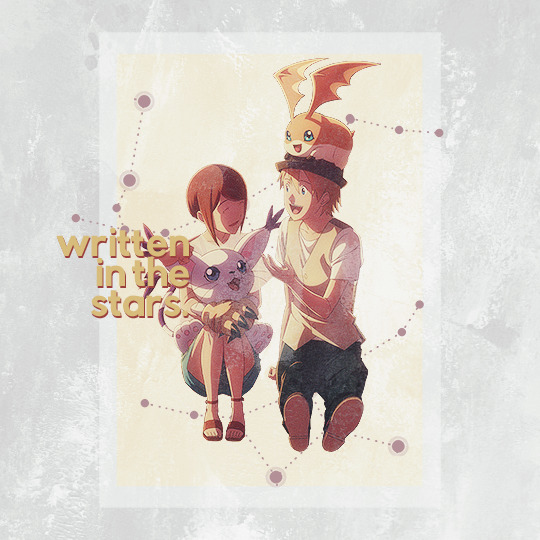
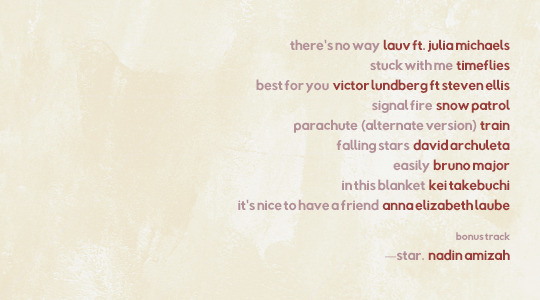
written in the stars; a takari playlist
for lovers who cast their hope on a light in the sky. (youtube / spotify)
01. there's no way - lauv feat. julia michaels
you touch me and it's almost like we knew that there will be history between us two
02. stuck with me - timeflies
open up the shades, sun is on the way
03. best for you - victor lundberg ft steven ellis
i know that you feel all alone in this world, but you have to put your trust into us
04. signal fire - snow patrol
hold me close cause i need you to guide me to safety
05. parachute (alternate version) - train
so open up and be my human angel
06. falling stars - david archuleta
you tell me it's not possible, no way that we could break
07. easily - bruno major
just because it won't come easily doesn't mean we shouldn't try
08. in this blanket - kei takebuchi
you don't have to try any harder cause you're trying enough you'll break
09. it's nice to have a friend - anna elizabeth laube
call my bluff, call you "babe", have my back, everyday
bonus tracks: —star. - nadin amizah
i might have never told you, but with you feels like everything is right
part 5 of lovers in japan series
for @takariweek 2021 day 7 / hope and light //
#digimon#by me#sorry i feel very worthless right now so no commentary currently#digiloversinjapan#digimusic#takari week#takeru takaishi#hikari yagami#takari
74 notes
·
View notes
Text
SCENT OF MYSTERY and the Lingering History of Smell in Cinema by Kim Luperi
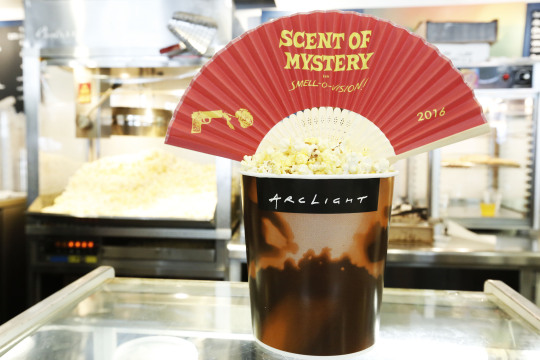
"First they moved (1895)! Then they talked (1927)! Now they smell (1960)!" taglines for SCENT OF MYSTERY (’60) proclaimed. And smell it did – like wine, garlic, cigar smoke, banana and an array of other aromas.
SCENT OF MYSTERY qualifies as the most unique screening I’ve attended at the TCM Classic Film Festival because, well, it’s the only aromatic cinematic experience I’ve ever encountered, recreated for the only movie produced in this particular process, Smell-O-Vision. The mystery travelogue follows a vacationer (Denholm Elliott) in Spain who randomly happens upon a plot to murder a young woman and dashes off throughout the country to stop the crime with the help of a taxi driver (Peter Lorre). Shot on location, the “mistery” movie—as Olorama Technology coined it—aimed to create an atmosphere that smelled just as authentic as the real-life locations viewers saw onscreen.
Though the idea of mixing scent and cinema stretches back to 1916, when a Pennsylvania theater unleashed a rose fragrance on an audience watching a Rose Bowl football game, the novelty failed to compete with the advent of two other ideas that wowed the senses during the 1920s: sound and color. A mere decade later, though, Hans Laube introduced a new scented technology at the 1939 New York World’s Fair: Smell-O-Vision. Laube felt this olfactory experience, which circulated scents through tubes connected to individual theater seats, could open up many possibilities in Hollywood, but that wasn’t the case.

Cut to the 1950s, a time when Hollywood was desperate to entice audiences away from their television screens. According to a 2006 Wired article, SCENT OF MYSTERY producer Michael Todd Jr. approached Laube to create a “smell brain,” a set of bottled scents dispensed automatically as the film ran through the projector. But by the late 1950s, there was competition: AromaRama, which actually debuted first in late 1959 with the documentary BEHIND THE GREAT WALL. While the idea was the same, the method differed, as AromaRama fragrances circulated through air-conditioning systems already in place.
“I felt strongly that the idea of putting smells into a theatre was a wild one,” Todd Jr. was quoted as saying in The New York Times. “The process was fun and it should be used in a way that got the most fun out of it.” But his valiant attempt turned out a failed effort. Despite lofty goals shared in a 1960 Variety article of running the film in 12 locations worldwide by the end of the year, SCENT OF MYSTERY only played three cities: Chicago, New York and Los Angeles. Critics bestowed mixed reviews, with some finding the plot uninspired and the scents a distracting crutch.
New York Times critic Bosley Crowther railed against the stunt, saying select odors were indistinguishable and belated; the aromas “are actually the least impressive” feature of the movie, he concluded, especially since some were meant to act as clues to the mystery! Additionally, the technology proved costly, estimated at around $12,000-$20,000 per location, with figures hitting $50,000 for a theater in Chicago. (For comparison, AromaRama installation ranged from $4,000-$8,000.) With those costs, negative critiques and flawed technology, fragranced innovation couldn’t save SCENT OF MYSTERY from bombing at the box office. The film was eventually removed from circulation and re-released, scentless, as HOLIDAY IN SPAIN in 1962.

TCM revamped the Smell-O-Vision experience for SCENT OF MYSTERY’s 2016 TCMFF screening in what I presume was a more cost-efficient manner, relying on audience participation via numbered mini perfume vials left on each seat and large Smell-O-Vision-branded units that pumped select fragrances throughout the theater. When our corresponding number appeared on screen, we spritzed away! Aromas including peach, peppermint, tobacco and fireworks wafted through the air throughout the movie, some more strongly than others as not every seat was occupied. The result? An amusing, if not slightly distracting, interactive experience that I remember – in all honesty – more vividly than the plot itself.
But aromatic cinema didn’t end with SCENT OF MYSTERY. John Waters revived the idea in his 1981 movie POLYESTER with an economical twist: Instead of elaborate scent systems, Waters crafted 10 scratch and sniff scents viewers unleashed signaled by numbers onscreen. In true Waters fashion, he played up the gimmick, dubbed Odorama, and subjected audiences to aromas of gasoline, pizza and flatulence, among others. Waters’ simpler, yet more reliable idea caught on (sans some of those smells!), and scratch and sniff cards were sold at convenience stories for 1980s television airings of SCENT OF MYSTERY and special screenings of RUGRATS GO WILD (2003) and SPY KIDS: ALL THE TIME IN THE WORLD (2011).
So, where will the idea of scent and cinema go from here? Companies today are exploring the possibilities of integrating fragrances into virtual reality, digital chats and other web content, but how long before the fad finally dissipates is the question.
#Diana Dors#smell-o-vision#Odorama#1950s#1960#smell#classic movies#old movies#Kim Luperi#TCM#Turner Classic Movies
50 notes
·
View notes
Text
SEPTEMBER
Agyd bläst in des Herbstes Horn.
Die Beere schwankt am Brombeerdorn.
Der Apfel fällt mit leisem Laut,
großauf am Bach die Distel blaut.
Die Schwalbe zieht, der Wanderschuh
treibt dunkel einer Heimat zu.
Gekühlte Tage, klar und schön,
mit braunem Laub und weißen Höhn:
Wie lange noch? Der Abend fällt,
Flurfeuer glimmt, Rauchnebel schwelt.
Nachhaus zu gehn, ist wohlgetan.
Sankt Michael, zünd die Lampe an!
1 note
·
View note
Photo
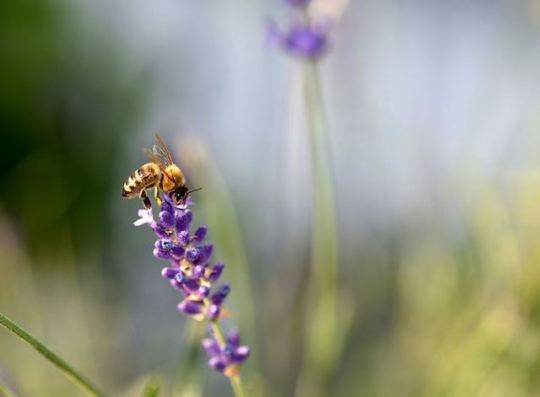
AUF MIR WÄCHST DER SOMMER
Auf mir wächst der Sommer
in mir summt der Honig
meine Hände sind Wind und Schwalbe zugleich
ich spreche die Sprache der Halme
ich lache das irre Gelächter der Gerüche
ich lebe mein Leben und das der anderen
ich trete in die Bilder ein
ich schreibe Laub und Schatten
und werde zu Laub und Schatten dabei
( Werner Lutz / Ich brauche dieses Leben )
Bild: by Michael on flickr
10 notes
·
View notes
Link
Check out this listing I just added to my Poshmark closet: Thomas Organ Solos Broadway Shows Mame Musical Sheet Music 1967 Jerry Herman Vtg.
0 notes
Text
Geführte Fackelwanderung für die ganze Familie (Kopie)
Winterlicher Wald, knisterndes Laub - oder gar Schnee? - unter den Schuhen… der Wind fegt durch kahle Äste… eine Atmosphäre wie geschaffen für viel Geschichte und spannende Geschichten rund um das Tal der Jahrtausende.
Ziel der Wanderung ist die Ruine der sagenumwobenen Hellkirch.
Nach Einbruch der Dunkelheit geht es mit Fackeln durch den dunklen Wald zurück. Die Tour ist ca. 6 km lang und auch für Kinder geeignet.
Ausgangspunkt der Wanderung im Hahnenbachtal ist die Wachholderheide in Woppenroth.
Kosten 15,00 €/Person Kinder zahlen die Hälfte
Information und Anmeldung bei Michael Brzoska
www.wandern-im-hunsrück.de
0 notes
Text
Voll Gold ein einsamer Mond
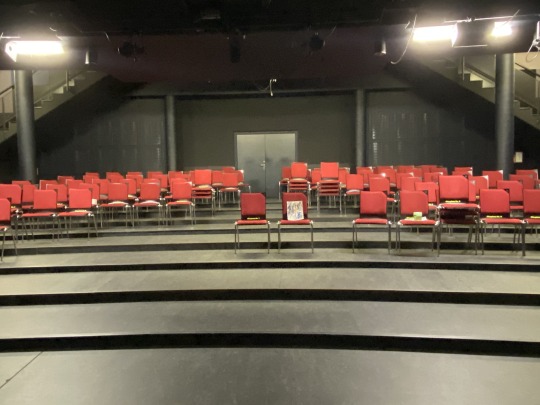
Voll Gold ein einsamer Mond
Gier übersättigt zwischen
Insel und Insel.
Seine Hände am Ufer, wenn du die Lampe anzündest.
Die Welt reflektiert, sofort ist Dickicht. Abend. Ein Knacken.
Ein Gallionsbild des Herzens, das schwebt, im tiefen Laub
Der Tiger ist voll angeschlagen, kein Aufbegehren, ein Morgen viel zu hell.
Neuer Unglauben, wiederum. Es hält jemand an und erschaudert.
Warum gerade zu mir Kolumbus?
Thanatos, Sohn der Nacht, Zwillingsbruder des Schlafes, schöner Junge, Genius
Mit dem Gesicht des Eros mit gelöschter Fackel in gesenkter Hand,
Scheucht er weg ein Warten.
(Michael Schilhan)


0 notes
Text
Video Premiere: Anna Elizabeth Laube "Jardim da Estrela"
Video Premiere: Anna Elizabeth Laube "Jardim da Estrela" @annalaube @chrisjoyner
Americana Highways hereby shares this lyric video premiere of Anna Elizabeth Laube’s song “Jardim da Estrela,” from her forthcoming album Annamania, due on January 22. The album was produced with vocal mixing by Anna Elizabeth Laube, guitar and accordion mixing by Michael Brauer. It was mastered by Jett Galindo. “Jardim da Estrela” is Anna Elizabeth Laube on electric and acoustic guitars,…

View On WordPress
0 notes
Link
Above is an exhibition from 2016, titled ‘Psychedelic’. It features artists artists Peter Bynum, Troy Simmons and Michael Laube.
I really liked the work by Troy Simmons, pictured below. The dull, concrete-like material juxtaposed with the bright geometric acrylic lines underneath seems to bring the vibrancy of the colours out more than usual. The article describes the artist’s aim to portray the relationship between man and nature, relating the work to the image of weeds and flowers growing in cracks on a pavement. To me, it conveys the idea of an attempt to cover up and hide the colour-fullness of the painting underneath. It also suggests bigger historical turning points, such as the complete prohibition of and war on drugs declared by President Nixon in 1971, when for decades the research into the therapeutic potential of psychedelic substances came to a halt. Instead, it’s as if the pendulum swung back fully the opposite way; the general population were fed the idea that taking them would would cause you to go insane and jump out of a window, or other ridiculous claims.
The style of painting reminds me a lot of Bridget Riley’s paintings and optical illusions, building upon the theme of the exhibition as a whole to bring to life “intensified and distorted sensory perception”. It’s very simple the way that the artist has covered part of the canvas, but the end result proposes a lot of different connotations. I have been interested in the idea of using oil pastel and layering to hide parts of my artwork and suggest duplicity - I could use this technique to create layered meanings through my work.

The work of Peter Bynum in this exhibition doesn’t grab my attention as much, though I do enjoy the way that the artists has used pressurised paint, illuminating it through glass to replicate very natural forms like the roots of a plant or tree. Painting onto glass or other transparent surfaces rather than opaque ones could give a similar vibrant style to my work. Using thick acrylic with a palette knife could give an interesting texture. I could potentially paint onto clingfilm or acetate this way. Additionally the connotations of using this kind of see-through material may compliment my ideas regarding duplicity and hidden layers quite well.
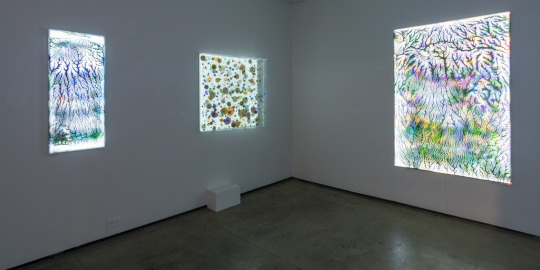
0 notes
Text
COVID-19 Claims the Lives of Three Jazz Greats
https://sciencespies.com/news/covid-19-claims-the-lives-of-three-jazz-greats/
COVID-19 Claims the Lives of Three Jazz Greats
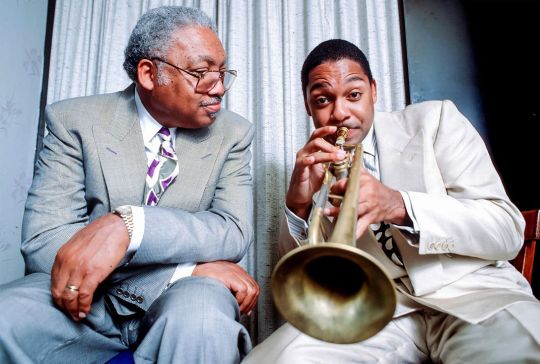
The jazz world lost three of its most legendary musicians to COVID-19 this week.
Trumpeter Wallace Roney died Tuesday in New Jersey, pianist and educator Ellis Marsalis Jr. died Wednesday in New Orleans, and guitarist Bucky Pizzarelli died on Wednesday in New Jersey. They were 59, 85 and 94, respectively.
Ellis Marsalis Jr.: A Father and Mentor to Jazz Players

American jazz musician Ellis Marsalis Jr (left) and his son, fellow musician Wynton Marsalis (right), backstage after a rare performance as a duo at the Blue Note nightclub, New York, New York, June 4, 1990.
(Photo by Jack Vartoogian / Getty Images)
Marsalis was a towering figure of modern jazz. Through his teaching, he became the patriarch of a musical family that extended well beyond the four sons who followed in his footsteps, report Janet McConnaughey and Rebecca Santan for the Associated Press.
“Ellis Marsalis was a legend,” wrote Mayor LaToya Cantrell of New Orleans, where the musician spent most of his life, on Twitter Wednesday night. “He was the prototype of what we mean when we talk about New Orleans jazz.”
The Marsalis family patriarch held teaching positions at the New Orleans Center for Creative Arts, Virginia Commonwealth University and the University of New Orleans. He had retired just this year from a three-decade stint playing weekly gigs at a small New Orleans club called the Snug Harbor Jazz Bistro.
“With the passing of Marsalis, we have lost not only a gifted pianist, but also a person committed to the importance of music education and jazz history,” says Theo Gonzalves, curator of cultural and community life at the Smithsonian Institution’s National Museum of American History.
Marsalis was known for his talents on the piano—he played alongside such greats as Cannonball Adderley and recorded more than 15 albums—but he was proudest of his legacy as a mentor and educator who carefully shepherded the next generation of musicians, including four of his six sons, reports Andrew Limbong for NPR.
“He was like the coach of jazz. He put on the sweatshirt, blew the whistle and made these guys work,” Nick Spitzer, host of public radio’s “American Routes” and a Tulane University anthropology professor, tells the AP.
Marsalis’ son Wynton is a trumpeter, as well as the artistic director of jazz at New York’s Lincoln Center. Branford took up the saxophone, leading “The Tonight Show” band and touring with Sting. Delfeayo, a trombonist, is a prominent producer and performer. Jason is a drummer of note with his band and as an accompanist. Marsalis’ two other sons—Ellis III, a poet-photographer, and Mboya—did not pursue music.
“My dad was a giant of a musician and teacher, but an even greater father. He poured everything he had into making us the best of what we could be,” says Branford in a statement.
Despite hailing from New Orleans, with its eponymous style of jazz, Marsalis’ musical heroes were virtuosic purveyors of bebop, including Charlie Parker and Thelonious Monk. His devotion to “straight-ahead jazz” trickled down to his sons, as well as other musicians he taught, including Terence Blanchard, Donald Harrison Jr., Harry Connick Jr. and Nicholas Payton, report Giovanni Russonello and Michael Levenson for the New York Times.
Marsalis’ children and students became the vanguard of “a burgeoning traditionalist movement, loosely referred to as the Young Lions,” write Russonello and Levenson in the Times. Roney, the trumpet player who died Tuesday, was one of these students.
In 2010, musician Anthony Brown and Ken Kimery, program director of Smithsonian Jazz, interviewed Marsalis for the Smithsonian Jazz Oral History Program. Recounting the conversation now, Kimery says the pianist “afforded us great insight into his family history, life in New Orleans,” favorite musicians and education, among other topics. The full transcript of the interview is available here.
Wallace Roney: Young Lion and Miles Davis Protégé

Wallace Roney performs at the Second Fandango Jazz Festival at La Palma in Rome, Italy.
(Photo by Ernesto Ruscio / FilmMagic)
Horn player and composer Wallace Roney was one of the “Young Lions” influenced by the Marsalises, but his chief association is with his idol and mentor, Miles Davis.
A pivotal moment in the pair’s relationship took place at the 1991 Montreux Jazz Festival, reports Nate Chinen for NPR. Davis, recruited by producer Quincy Jones to perform two of his albums, insisted that Roney, who stood in for him during rehearsals, join him onstage.
The younger musician “instinctively jumped in to handle some of the more technically demanding parts, and implicitly joined a chain of succession,” writes Chinen.
This public endorsement from arguably the most famous trumpet player of all time immediately launched Roney to a new height of jazz celebrity—but it also dogged him as he sought to differentiate himself.
“[A]s his career went on, Mr. Roney managed to neutralize most of those criticisms,” writes Giovanni Russonello for the New York Times. “His nuanced understanding of Davis’s playing—its harmonic and rhythmic wirings as well as its smoldering tone—was only part of a vast musical ken. His own style bespoke an investment in the entire lineage of jazz trumpet playing.”
Roney released just under 20 albums as a bandleader. Fittingly, he won a 1994 Grammy for the album A Tribute to Miles.
A 1987 profile of Roney by James McBride of the Washington Post gave the musician a simple and unqualified introduction: “His name is Wallace Roney III. He is 27 years old. He is from Washington, and he is one of the best jazz trumpet players in the world.”
Critic Stanley Crouch, meanwhile, recalled a performance delivered by a teenage Roney in a 2000 profile for the New York Times.
“As soon as Mr. Roney commenced to swing, the noise level in the club immediately dropped off, and those in the middle of conversations or laughing and joking turned their attention to the bandstand,” wrote Crouch. “At the end of the tune, the room took on a crazily jubilant mood, and the clapping wouldn’t stop.”
Bucky Pizzarelli: A Supporting Player Who Moved to Center Stage
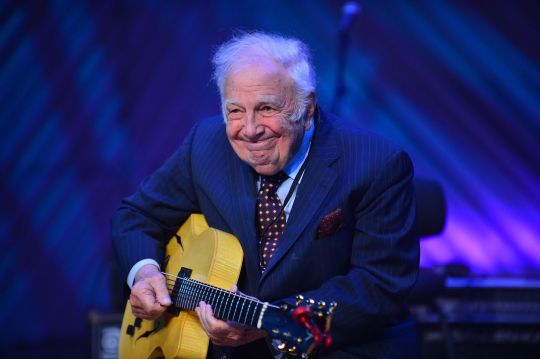
Bucky Pizzarelli performs onstage at Living Legends of Jazz during Miami Beach Jazz Fest on January 10, 2015.
(Photo by Johnny Louis / Getty Images)
The eldest of the three jazz men who passed away this week was Bucky Pizzarelli, “a tasteful sage of jazz guitar who spent the first phase of his career as a prolific session player and the last phase as a celebrated patriarch,” according to Nate Chinen of NPR.
Pizzarelli’s tremendous command of his instrument allowed him to draw “attention to the song he was playing, rather than the playing itself,” adds Chinen. “His rock-solid rhythmic footing and broad harmonic understanding were hallmarks of a warmly understated style.”
Describing Pizzarelli as “a master of the subtle art of rhythm guitar as well as a gifted soloist,” Peter Keepnews of the New York Times notes that the musician appeared on hundreds of records across genres. More often than not, he went uncredited.
Pizzarelli toured with Benny Goodman and was a stalwart in Johnny Carson’s “Tonight Show” orchestra before the talk show moved taping from New York City to Los Angeles in 1972. When the production’s cast and crew packed up, Pizzarelli stayed behind and began making a name for himself in New York nightclubs.
The musician is survived by his son John, also a renowned jazz guitarist. The father-son duo performed and recorded together many times.
Pizzarelli’s signature seven-stringed guitar is on display at the National Museum of American History. The guitar’s extra string was tuned to a low A, allowing him to provide a bass line even when playing alone or in concert with another guitar player. The jazz legend—who performed into his 90s despite multiple hospitalizations caused by stroke and pneumonia—played the guitar up until the day he donated it to the museum in 2005.
In a 2016 interview with Inside Jersey’s Jay Lustig, guitarist Ed Laub, a student and collaborator of Pizzarelli’s, aptly summed up his mentor’s approach: “It’s about making beautiful music. It’s not about grandstanding. And that’s what his whole personality is about.”
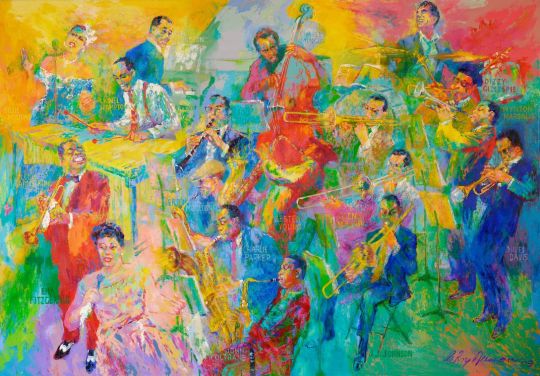
LeRoy Neiman, Big Band, 2005
(LeRoy Neiman / Photo by Richard Strauss, NMAH)
Reflecting on the trio of jazz giants’ legacy, curator Theo Gonzalves looks to a LeRoy Nieman painting on view at the National Museum of American History.
Called Big Band, it “features 18 of the greatest performers and composers of American music,” says Gonzalves. “When musicians like Wallace Roney, Bucky Pizarelli, and Ellis Marsalis pass away, we are lucky that we can take some solace by listening to their recordings. But isn’t it a comforting thought as well to imagine them, in a way that Nieman does, performing in concert for eternity?”
#News
0 notes